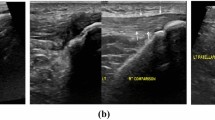Abstract
Background
The etiology of carpal tunnel syndrome (CTS) remains idiopathic in many cases. Noninflammatory fibrosis of the subsynovial connective tissue (SSCT) within the carpal tunnel is common in CTS, and some clinicians have hypothesized that this fibrosis might be a cause rather than an effect of CTS. An animal model in which to test this hypothesis would be useful. The principal objective of this study was to investigate the effect of a surgical injury on SSCT fibrosis and median nerve function within the carpal tunnel in an in vivo rabbit model.
Methods
Rabbits were sacrificed 12 weeks after surgery and were evaluated by mechanical testing, histology, transmission and scanning electron microscopy, and electrophysiology.
Results
SSCT fibroblast density (p < 0.0001) and collagen fiber size (p = 0.0004) were significantly higher, and the median nerve distal motor amplitude was significantly lower (p = 0.0018), in the tendon injury group SSCT than in either the sham or control groups.
Conclusions
Our findings are similar to those seen in patients with carpal tunnel syndrome and suggest that the tendon injury procedure may be the basis of a new animal model of SSCT injury and, possibly, CTS.







Similar content being viewed by others
References
Ettema AM, Amadio PC, Zhao C, et al. A histological and immunohistochemical study of the subsynovial connective tissue in idiopathic carpal tunnel syndrome. J Bone Joint Surg Am. 2004;86-A:1458–66.
Ettema AM, Amadio PC, Zhao C, et al. Changes in the functional structure of the tenosynovium in idiopathic carpal tunnel syndrome: a scanning electron microscope study. Plast Reconstr Surg. 2006;118:1413–22.
Ettema AM, Zhao C, An K-N, et al. Comparative anatomy of the subsynovial connective tissue in the carpal tunnel of the rat, rabbit, dog, baboon, and human. Hand. 2006;1:78–84.
Frank C, Bray D, Rademaker A, et al. Electron microscopic quantification of collagen fibril diameters in the rabbit medial collateral ligament: a baseline for comparison. Connect Tissue Res. 1989;19:11–25.
Frank C, McDonald D, Bray D, et al. Collagen fibril diameters in the healing adult rabbit medial collateral ligament. Connect Tissue Res. 1992;27:251–63.
Frank C, McDonald D, Wilson J, et al. Rabbit medial collateral ligament scar weakness is associated with decreased collagen pyridinoline crosslink density. J Orthop Res. 1995;13:157–65.
Lim JY, Cho SH, Han TR, et al. Dose-responsiveness of electrophysiologic change in a new model of acute carpal tunnel syndrome. Clin Orthop Relat Res. 2004;120–6.
Lluch AL. Thickening of the synovium of the digital flexor tendons: cause or consequence of the carpal tunnel syndrome? J Hand Surg Br. 1992;17:209–12.
Loong SC. The carpal tunnel syndrome: a clinical and electrophysiological study of 250 patients. Clin Exp Neurol. 1977;14:51–65.
Mackinnon SE, Dellon AL, Hudson AR, et al. Chronic nerve compression—an experimental model in the rat. Ann Plast Surg. 1984;13:112–20.
Mackinnon SE, Dellon AL, Hudson AR, et al. A primate model for chronic nerve compression. J Reconstr Microsurg. 1985;1:185–95.
McDowell EM, Trump BF. Histologic fixatives suitable for diagnostic light and electron microscopy. Arch Pathol Lab Med. 1976;100:405–14.
Nordstrom DL, DeStefano F, Vierkant RA, et al. Incidence of diagnosed carpal tunnel syndrome in a general population. Epidemiology. 1998;9:342–5.
Oh S, Ettema AM, Zhao C, et al. Dextrose-induced subsynovial connective tissue fibrosis in the rabbit carpal tunnel: a potential model to study carpal tunnel syndrome? Hand. 2008;3:34–40.
Okutsu I, Ninomiya S, Yoshida A, et al. Measurement of carpal canal and median nerve pressure in patients with carpal tunnel syndrome. Tech Hand Up Extrem Surg. 2004;8:124–8.
Pavesi G, Olivieri MF, Misk A, et al. Clinical–electrophysiological correlations in the carpal tunnel syndrome. Ital J Neurol Sci. 1986;7:93–6.
Seradge H, Jia YC, Owens W. In vivo measurement of carpal tunnel pressure in the functioning hand. J Hand Surg Am. 1995;20:855–9.
Spurr AR. A low-viscosity epoxy resin embedding medium for electron microscopy. J Ultrastruct Res. 1969;26:31–43.
Stevens JC, Sun S, Beard CM, et al. Carpal tunnel syndrome in Rochester, Minnesota, 1961 to 1980. Neurology. 1988;38:134–8.
Tankisi H, Pugdahl K, Johnsen B, et al. Correlations of nerve conduction measures in axonal and demyelinating polyneuropathies. Clin Neurophysiol. 2007;118:2383–92.
Wallis MA, Griffin RL. A routine method for embedding animal tissues in Spurr resin for electron microscopy. J Clin Pathol. 1973;26:77–8.
Yamaguchi T, Osamura N, Zhao C, et al. The mechanical properties of the rabbit carpal tunnel subsynovial connective tissue. J Biomech. 2008;41:3519–22.
Yoshii Y, Zhao C, Schmelzer JD, et al. The effects of hypertonic dextrose injection on connective tissue and nerve conduction through the rabbit carpal tunnel. Arch Phys Med Rehabil. 2009;90:333–9.
Acknowledgments
This study was funded by a grant from NIH (NIAMS AR 49823). The authors sincerely thank Ramona L. Kirk for her assistance with animal care.
Conflicts of Interest
The authors declare they have no conflict of interest.
Author information
Authors and Affiliations
Corresponding author
About this article
Cite this article
Moriya, T., Zhao, C., Cha, S.S. et al. Tendon injury produces changes in SSCT and nerve physiology similar to carpal tunnel syndrome in an in vivo rabbit model. HAND 6, 399–407 (2011). https://doi.org/10.1007/s11552-011-9356-2
Published:
Issue Date:
DOI: https://doi.org/10.1007/s11552-011-9356-2




